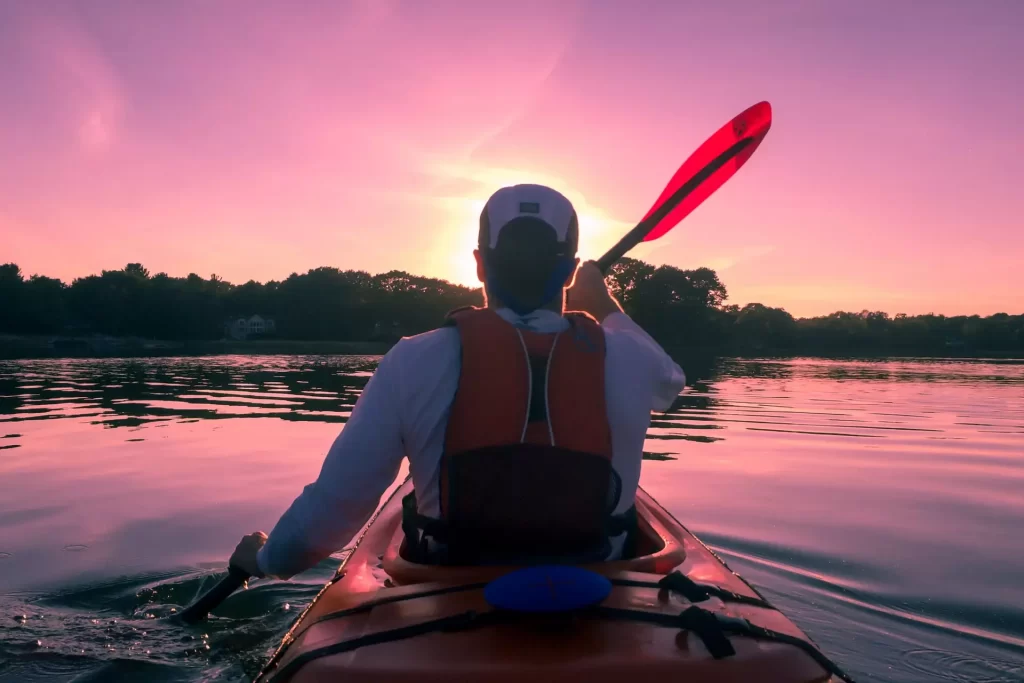Kayaking is an exciting and accessible outdoor activity that allows you to explore rivers, lakes, and coastal areas from a unique perspective. Whether you’re looking for a serene escape or an adrenaline rush, kayaking offers something for everyone.
If you’re a beginner eager to hit the water, here are some essential facts to consider before you start your kayaking journey.
Table of Contents
1. Choosing the Right Kayak
Types of Kayaks
There are several types of kayaks, each designed for specific activities:
- Recreational Kayaks: Stable and easy to maneuver, ideal for calm waters and beginners.
- Touring Kayaks: Longer and designed for longer distances, suited for lakes and coastal waters.
- Whitewater Kayaks: Shorter and more maneuverable, built for rapids and river currents.
- Sit-on-top Kayaks: Great for warm weather, easy to get in and out of, perfect for casual paddling.
- Sit-in- Kayaks: sit-in kayaks are an excellent choice for those looking for comfort, stability, and the ability to handle various water conditions.
Choose a kayak that matches your intended use and skill level.
Fit and Comfort
Ensure the kayak fits you well. A snug seat and proper legroom are crucial for comfort during longer paddles. Most recreational kayaks are designed to be user-friendly, but try before you buy or rent.
2. Essential Gear
In addition to a kayak, you’ll need some basic gear:
- Paddle: Length of the paddle is very crucial for enjoyable kayaking. Choose a paddle according to your height. A lightweight paddle reduces fatigue.
- Personal Flotation Device (PFD): A properly fitting life jacket is essential for safety.
- Clothing: Dress in layers and consider moisture-wicking fabrics. Based on the weather of your kayaking location you should know what to wear during kayaking. Cotton fabric is not recommended as it absorb water for long and can make you shivering in cold weather.
- Safety Gear: Whistle, bilge pump, and a first aid kit are important for safety.
3. Safety First
Understanding the Environment
Before heading out, familiarize yourself with the body of water you’ll be kayaking. Check local weather conditions, tide schedules, and potential hazards like rocks, strong currents, and busy boat traffic.
Know Your Limits
Start with easy, calm waters. As you feel confident after having some kayaking experience, increase you kayaking difficulties if you want. Always kayak with a buddy if possible, and inform someone about your plans.
4. Basic Paddling Techniques
Beginner paddlers should start by learning the basic paddling techniques and building their strength and stamina. This will help them to navigate their watercraft, maintain balance and stability, and control the direction of travel.
Some of the most important paddling skills for beginners to master include the forward stroke, the J-stroke, and the low brace turn. With proper instruction and practice, these skills will provide a solid foundation for beginner paddlers to build upon as they continue to develop their paddling abilities.
Forward Stroke
The forward stroke is used to propel the canoe forward. It involves dipping the paddle in the water on one side of the canoe and pulling it towards the rear of the canoe. The forward stroke is the most basic paddling technique and is used to cover distance or move the canoe in a desired direction.
By alternating the side on which the paddle is dipped and pulled, the paddler can maintain a steady pace and keep the canoe moving forward. The forward stroke is an essential technique for any paddler, regardless of the type of watercraft or the purpose of the trip.
Reverse Stroke
Similar to the forward stroke but applied in the opposite direction, used to move the canoe backward.
J-Stroke
Involves a combination of a forward stroke and a ruddering action, where one side of the paddle is dipped deeper in the water and angled to steer the canoe. This allows the paddler to keep the canoe moving forward while also making adjustments to the direction of travel.
The J-stroke is an important technique for maintaining control and stability when paddling in open water or navigating through tight spaces, such as narrow channels or around obstacles.
Draw Stroke
A pulling motion, where the paddle is placed near the canoe and then pulled towards the paddler to move the canoe sideways.
Stern Draw Stroke
Similar to the draw stroke, but applied at the back of the canoe to move the stern in the desired direction.
Sculling
A gentle back-and-forth motion of the paddle near the canoe to maintain balance and control, or to make small adjustments in direction.
Low Brace Turn
Involves planting one blade of the paddle vertically in the water and using it as leverage to turn the canoe in a specific direction.
High Brace
High brace is used to counterbalance the canoe when it begins to tip. The paddle is positioned vertically in the water on the side opposite the tilt to stabilize the canoe.
In summary above kayaking techniques for beginner must be learnt:
Essential kayaking techniques for beginners in short
Learn the proper grip for your paddle: hold it lightly with your knuckles facing up. Practice the following basic strokes:
- Forward Stroke: Use alternating strokes on each side to move forward.
- Reverse Stroke: Pull the paddle back on each side to move backward.
- Draw Stroke: Reach the paddle out to the side and pull towards the kayak to change direction.
- Sweep Stroke: Create a wide arc with the paddle on one side to turn the kayak.
Balance and Posture
Balancing is one of the important safety techniques during kayaking. Most of the beginners fail to keep kayaking due to this balancing problem. Your should keep you upright and keep your foot flat.
Keep your body relaxed to maintain balance. As you gain experience these problem will not arise in your mind because your body become trained by the time being.
5. Learning Resources
Think about enrolling in a beginner kayaking course to gain fundamental skills from knowledgeable instructors. Numerous outdoor centers provide classes that focus on safety, paddling techniques, and navigating local waterways.
6. Respecting the Environment
When you’re out kayaking, it’s important to adhere to Leave No Trace principles:
- Refrain from disturbing wildlife.
- Follow the local regulations and designated path provided by the authority.
- Properly dispose of waste and aim to minimize your environmental footprint.
Conclusion
Kayaking offers a rewarding and exciting way to engage with nature and stay active. By grasping the fundamentals, selecting appropriate gear, emphasizing safety, and being mindful of the environment, you can fully enjoy your kayaking experiences as a beginner. So gear up, get on the water, and savor the adventure!



Pingback: Basics of kayaking: All you need to learn before start paddling! - Safekayaking